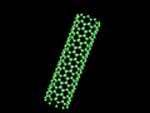New method sorts nanotubes by size

Rice University scientists have developed the first method for sorting semiconducting carbon nanotubes based on their size, a long-awaited development that could form the basis of a nanotube purification system capable of producing the necessary feedstocks for nano-circuits, therapeutic agents, next-generation power cables and more.
Nanotubes, tiny cylinders of carbon no wider than a strand of DNA, possess a tantalizing array of properties coveted by materials scientists. Nanotubes are stronger than steel, but weigh one sixth as much. Some varieties are excellent semiconductors, while others are metals that conduct electricity as well as copper.
But there are dozens of varieties of nanotubes, each slightly different in size and atomic structure and each with very different properties. For many applications, engineers need to use just one type of nanotube, but that's not possible today because all production methods turn out a mishmash of types.
New research due to appear in an upcoming issue of the Journal of the American Chemical Society describes a new method that uses electric fields to sort nanotubes by size.
"People have developed sorting methods based on both chemical and electrical properties, but ours is the first that's capable of sorting semiconducting nanotubes based upon their dielectric constant, which is determined by their diameter," said corresponding author, Howard Schmidt, executive director of Rice's Carbon Nanotechnology Laboratory (CNL).
To sort nanotubes, the CNL team built a system that capitalizes on the fact that each type of nanotube has a unique dielectric constant – a term that refers to a material's ability to store electrostatic energy. CNL scientists created an electrified chamber and pumped a solution of dissolved nanotubes through it. The chamber traps metallic nanotubes and causes semiconducting varieties to float at different levels in the chamber.
The smaller the diameter of the nanotube, the larger the dielectric constant and the lower in the system the tubes float. By varying the speed of flow through the system – with upper-level currents traveling faster than lower-level currents – the scientists were able to collect samples that had three times more small tubes than large and vice versa.
Source: Rice University





















